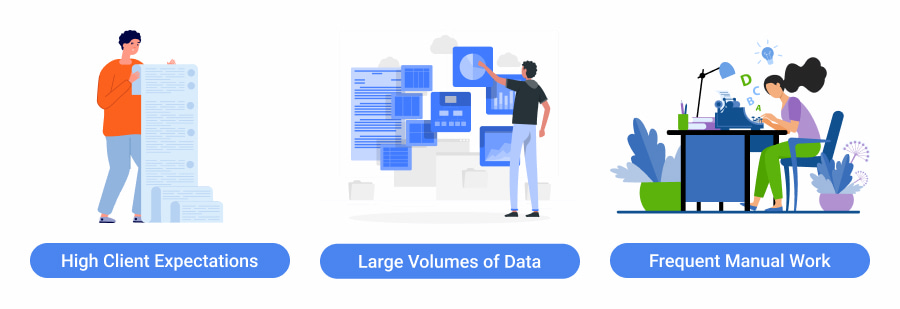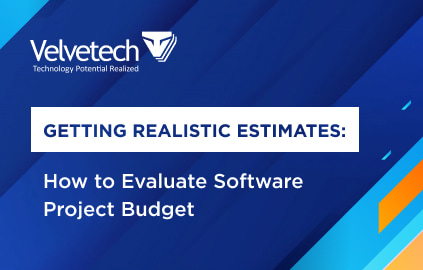On a daily basis, insurance companies have to deal with myriads of tedious manual tasks that exhaust employees and take up a lot of valuable time. From quoting and underwriting to policy management and claims processing — there’s an extensive to-do list that insurers have to continuously tackle.
Hence, it’s no surprise that businesses are increasingly looking at insurance software to help with the workload and optimize operations. After all, whichever company can deliver services of the highest quality and most efficiently will end up outpacing competitors in the long run.
One of the innovations that has been of particular interest recently is robotic process automation (RPA) in insurance. So, that is what will be the focus of today’s article. Namely, we’ll discuss the following key points:
Let’s get right into it.
Key Drivers of RPA in Insurance Adoption

RPA in the insurance industry refers to the use of software robots for routine task automation. The bots can seamlessly integrate through APIs with solutions that you already have on hand and quickly allow you to reap the rewards.
With the help of this technology, insurers can get rid of some manual human work like the collection and input of customer information into various systems, extraction of key data from new claims, and the like.
By streamlining daily tasks and eliminating work that takes up too much time and energy, robotic process automation empowers your workforce, increases efficiencies, and reduces operational costs. Yet, even though the benefits of RPA in insurance are quite vast, what exactly is driving the adoption of this technology?
High Client Expectations
First and foremost, client expectations are higher than ever across all kinds of industries and insurance is no exception. People don’t want to spend too much time waiting for quote estimates, underwriting procedures to be completed, and their claims to be settled.
Hence, insurer’s are eager to speed up their internal processes in order to deliver top-notch customer experiences. Given RPA’s capabilities, it’s no surprise many are looking to this technology for help.
Discover 7 Ways to Improve Customer Experience
Large Volumes of Data
Another major RPA adoption driver is the large volumes of data that insurance companies have to deal with. Digital information can provide valuable insights about a potential client. So, it’s of utmost importance for insurers to obtain it all.
Financial history, previous claim filings, data from connected devices, and other kinds of details should all be analyzed by insurers to get a better understanding of a customer. Of course, this can be rather taxing on your employees and make you eager to simplify the process.
Frequent Manual Work
The above-mentioned large volumes of data require a lot of work on a regular basis for insurance staff. Whether it’s centralizing information from multiple documents into one system or manually assessing risk during underwriting, there are always repetitive tasks on the to-do list.
Naturally, getting rid of that manual labor can empower your employees to focus more on value-adding activities like one-on-one, personalized interactions with clients. As you may have already guessed, RPA can help with that.
Find out if Hyper-Personalization in Insurance Is a Must
Top 5 Robotic Process Automation Use Cases in Insurance
Now that we’ve covered what drives the high demand for RPA services, it’s time to get into more specifics. While there are many uses for RPA in insurance, we’re going to focus on the five main ones that might be of interest to you.

1. Underwriting
Underwriting is an extensive process of assessing the degree of risk associated with providing a specific customer with insurance coverage. In health insurance, it might involve looking over a person’s medical history, presence of pre-existing conditions, and the like. Conversely, in auto insurance, it’s probably more relevant to look at the driving history, choice of vehicle, etc.
Learn how we built Onboarding and Underwriting Software
Whatever the case might be, a lot of data has to be analyzed for an insurer to complete the underwriting process and identify the appropriate rate to charge a client.
RPA implementation can help in this insurance activity by automating data collection, transferring details to internal systems, and presenting the key insights in an easy-to-understand manner via intelligent dashboards. Thus, speeding up the entire endeavor.
Further, by adding artificial intelligence and machine learning technology, the information aggregated by the bots can also be swiftly analyzed to unearth patterns that might be invisible to the human eye. Thus, letting you predict the riskiness of a client with a high degree of accuracy and thus offer a premium price that you’re comfortable with.
Uncover the Value of Predictive Analytics in Insurance
2. Claims Management
Another one of RPA usage examples in insurance lies within claims management. As you know, clients are looking for a quick response whenever an insured event occurs and they file a claim.
However, claim processing is a highly time-consuming undertaking. After all, the company has to check that all the documents are in order, look into what actually happened, and ensure there’s no insurance fraud taking place. In medical claims processing for example, an insurer wants to be certain that healthcare services were in fact provided to the client in question.
With robotic process automation, everything is sped up. The technology can quickly extract necessary data from documents, identify errors, and unify all claim-related information. Thus, helping staff swiftly settle standard claims and focus on dealing with those that require more scrupulous attention.
Read up on how we helped an Insurance Consultant Automate Document Processing
3. Policy Administration
Policy management typically encompasses the majority of processes involved in running an insurance business. Quoting, proposal generation, claims settlement, loss run report creation, and compliance checking are all crucial tasks when delivering insurance services.
Naturally, policy administration requires working with a multitude of documents on a regular basis. RPA can help streamline that by automatically updating all of your internal systems when you make a change in a specific file. Thus, eliminating the need for repetitive updating of information across the entire organization.
Moreover, RPA solutions can seamlessly extract data from customer emails, call transcripts, web forms, and other sources of information to quickly refresh details in your CRM platforms and other relevant databases. Unsurprisingly, this type of automation can come in handy when your staff is slammed with work.
Find out how an Insurance Company Automated Internal Processes
4. Regulatory Compliance
Ensuring compliance with industry and country-specific regulations is of utmost importance for any organization. Unfortunately, manual control by employees comes with the potential for unintentional human errors, which can make a company liable and lead to enormous costs.
Once again, robotic process automation can optimize this task. You see, the robots are only going to follow the instructions that they’ve been provided with and always maintain an extensive record of changes for you to double check if needed. Hence, the likelihood of errors can diminish significantly.
Additionally, RPA-powered tools can easily generate compliance-related reports on a regular basis. Thus, keeping you informed and calm about the state of your regulatory adherence.
5. Financial Accounting
Businesses from all kinds of industries require financial accounting. After all, someone’s got to keep track of invoice processing, payroll management, and the handling of all other company transactions.
With RPA, you can get rid of manual accounting tasks and allow the software to automatically fill out templates, copy and paste information onto an invoice, and even create financial reports that succinctly summarize all the key data. In essence, if there’s repetitive work to be done — RPA can take care of it for you.
How to Implement RPA in Insurance

Having discovered the top uses of RPA in the insurance sector, you might be wondering what the implementation process of this technology might look like. Well, there are several key steps you ought to keep in mind.
Identify procedures to automate. First of all, you’ve got to figure out which of your existing processes can benefit from RPA. We’ve given you some ideas above, but perhaps you have other tasks that need taking care of. Just remember, RPA is great for automating data processing, getting rid of repetitive tasks, and generally boosting efficiency.
Set up a plan for RPA deployment. Once you’ve identified the areas that can benefit from RPA, it’s important to get your priorities straight and figure out which ones are worth automating first. A carefully laid out implementation strategy will help you stay on track.
Assign responsibility. For a project to be successful, there has to be someone in charge of development and focused on the results. Whether you’re working with an internal IT team or outsourcing to an external vendor, it has to be clear who is responsible for the project.
Implement RPA. After your plan is outlined, a project leader is assigned, and a team is assembled, it’s time to add RPA to your IT infrastructure.
Train your staff. Once the RPA tools are incorporated into your organization, don’t forget to train your employees to use them most effectively. The new working methods must be thoroughly explained and practiced in order to be truly beneficial to your business.
That’s it for the RPA implementation process. However, don’t forget that as soon as RPA is embedded into your company, you should monitor its effects.
Has your efficiency increased? Are employees spending less time on manual tasks? Did the customer experience improve? Keep track of the important metrics to make sure your undertaking has yielded positive results.
Project Estimates
Watch our webinar to learn about the practical ways to evaluate your software project estimates.
Get Started with RPA
As we have seen today, RPA can be beneficial in all insurance areas — property and casualty, healthcare and life, or even travel. At the end of the day, all of these industry sectors have repetitive work on their hands and are eager to reduce the amount of manual tasks.
So, no matter the insurance company you come from, the implementation of RPA tools should definitely be something you consider. At Velvetech, we can help you determine whether it is the right next step for you or if you might benefit from other IT solutions first.
Our team has spent years building impeccable insurance software and is well-equipped to guide you on your digital transformation journey. Don’t hesitate to reach out and schedule a consultation. We’re always excited to jump into a new project and solve our clients’ challenges.































